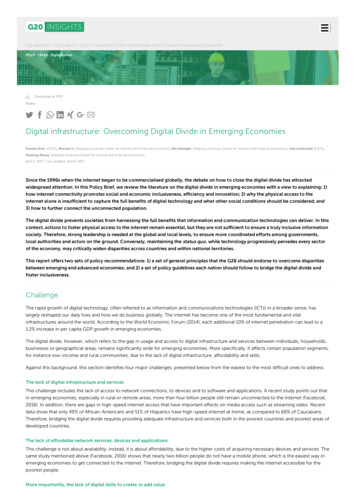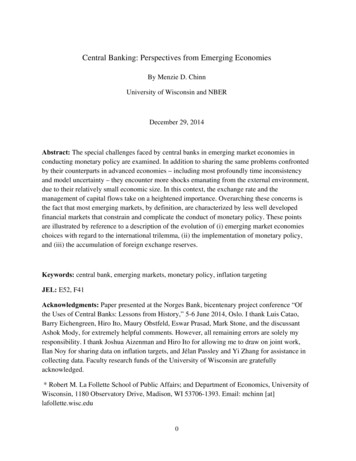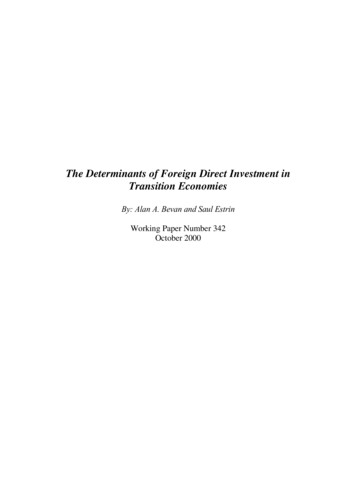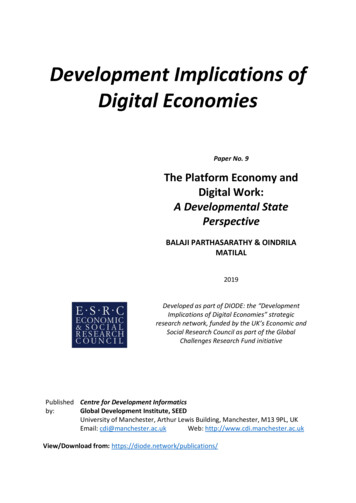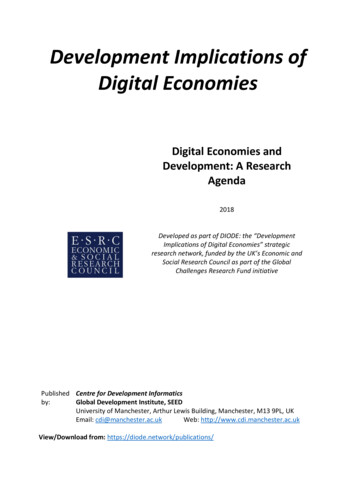
Transcription
Development Implications ofDigital EconomiesDigital Economies andDevelopment: A ResearchAgenda2018Developed as part of DIODE: the “DevelopmentImplications of Digital Economies” strategicresearch network, funded by the UK’s Economic andSocial Research Council as part of the GlobalChallenges Research Fund initiativePublished Centre for Development Informaticsby:Global Development Institute, SEEDUniversity of Manchester, Arthur Lewis Building, Manchester, M13 9PL, UKEmail: cdi@manchester.ac.ukWeb: http://www.cdi.manchester.ac.ukView/Download from: https://diode.network/publications/
Table of ContentsOVERVIEW . 1A. DIGITAL INEQUALITY. 3B. DIGITAL LABOUR. 5C. DIGITAL PLATFORMS . 7D. DIGITAL ENTERPRISE . 9E. DIGITAL POLICY . 11F. DIGITAL ECONOMY THEORY AND METHODS. 13REFERENCES . 14
Digital Economies and Development:A Research AgendaDevelopment Implications of Digital Economies (DIODE) Strategic Research NetworkFunded by the UK’s Economic and Social Research Council2018This short paper summarises the research agenda emerging from the work of the“Development Implications of Digital Economies” (DIODE) Strategic Research Network, whichwas funded by the UK’s Economic and Social Research Council as part of the Global ChallengesResearch Fund.OverviewWhy research digital economies and development?First, because of the increasing importance of the digital economy which may be defined as“that part of economic output derived solely or primarily from digital technologies with abusiness model based on digital goods or services” (Bukht & Heeks 2017:13) andconceptualised as shown in Figure 1. Rough estimates place its value around 5% of global GDP;contributing around 3% of global employment; and typically registering double-digit annualgrowth (ibid.).Broad Scope: Digitalised EconomyNarrow Scope: Digital EconomyCore: Digital (IT/ICT) mationservicesDigitalservicesSoftware &IT y 4.0PrecisionagricultureAlgorithmiceconomySharing economyGig economyFigure 1: Scoping the digital economySource: Bukht & Heeks (2017)Second, because digital economies in developing countries are falling well short of theirdevelopment potential due to various constraining challenges; for example with nationalcontributions to GDP and employment roughly half that seen in the global North, and even less1
in least-developed countries (ibid). Yet, alongside these constraints, the rapid growth of thedigital economy in developing countries has been associated with emergent harms: growth indigital exclusion and wider digital inequality including emergence of digital monopolies, andgrowth in other digital harms such as threats to security and privacy (Bukht & Heeks 2018).Third, because of extensive knowledge gaps around the two rationales just stated. We haveonly the roughest idea of the size of the digital economy in the global South. We lackknowledge about the nature of constraints to growth and how to overcome them. We knowlittle about the harms and disbenefits of digital economy growth.The DIODE network therefore undertook a set of four workshops during 2017-2018 andcommissioned a series of working papers: for further details of both, seehttps://diode.network/. The intention was to identify the key knowledge gaps relating to thedigital economy in developing countries, and to therefore identify the future research agenda.This paper presents the outcome of those activities. It divides the research agenda into sixoverall topic areas as discussed below: Digital inequality, Digital labour, Digital platforms,Digital enterprise, Digital policy, and Digital economy theory and methods.In all cases, there was a cross-cutting concern to understand the specifics of these phenomenain the global South given the consistent theme that phenomena, contexts, impacts, etc. weredifferent from the mainstream discourse which is dominated by research and evidence fromand about the global North. Differential issues included: Institutional differences between the digital economy context of the global South vs. globalNorth. The contrast between “book realities” vs. “field realities” of developing country digitaleconomy: assumptions of global North researchers that are not matched by realities in theglobal South – either more positive or more negative. The challenge of applying digital economy strategies (policy, enterprise strategy, activism)formed in the global North to the global South.2
A. Digital InequalityThe key challenge, overarching knowledge gap and main research priority relating to the digitaleconomy in developing countries was seen to be digital inequality: the unequal distribution ofdigital resources, processes, benefits and harms across various social dimensions. Thisinequality occurs between nations and between social groups on bases including income,gender, education, location, age, disability, ethnicity, etc. (Heeks 2018). As shown in Figure 2,the original focus of attention was the “digital divide”: concern about inequalities ofinfrastructure and then of access to and use of digital technologies. But in recent years, thishas extended to the broader notion of “digital inequality” which includes the skeweddistribution of digital impacts.Level of DigitalActivityImpact- Micro-Outputs- Outcomes- Development ImpactUptake- Demand- Usage- Use DivideReadiness- Institutions- Infrastructure- Digital DivideAvailability- Supply- Implementation andDesignTimeFigure 2: Changing focus of digital inequality over timeSource: adapted from Heeks (2018)The digital divide remains a critical problem: involvement in the digital economy typicallyrequires Internet access yet roughly half the planet’s population is not yet connected, with thisgroup disproportionately representing the world’s poor, female, and rural citizens indeveloping countries (Alliance for Affordable Internet 2017). But these problems are replicatedwithin the digital economy itself. Men earn more than women, and those in the global Northearn more than those in the global South when working via digital platforms (Bukht & Heeks2018). Digital engagement by developing country micro-, small and medium enterprises tendsto reinforce rather than reduce their marginalisation (Murphy & Carmody 2015). Conversely,large global platforms tend to oligopolistic or even monopolistic capture of markets and theirincome streams.Three research priorities were identified:1. Mapping Digital Inequality: identifying the emergent nature of digital economy-relatedinequalities in developing countries. Understanding overall the extent to whichinvolvement in the digital economy closes, reproduces or widens existing inequalities.Understanding specifically how the multiple structural dimensions of inequality (economic,3
socio-cultural, political, spatial, epistemic) intersect and interact with the emergence of thedigital economy in developing countries either to create digital inequality: exclusions,harms and asymmetrical benefits related to the digital economy, or to disrupt the statusquo in favour of equity.2. Supporting Digital Labour: understanding and increasing value capture by workers in thedigital economy. A core source of digital inequality is the inequity of power betweencapital and labour; enabling capital to capture more of the value and benefits of emergentdigital economy phenomena in developing countries. This research priority – explainedfurther in Section B – would try to redress this imbalance.3. Feminist Digital Economics: developing gendered understanding of, and intervention in thedigital economy in the global South. Identifying the digital economy gender asymmetries ofcontext, activity and impact. Based on that understanding, intervening to address thesources of digital economy inequality including structures that skew women’s participationrates in and benefits from digital entrepreneurship and labour.Other elements of the research agenda include: Pro-Equity Interventions: analysing and supporting pro-equity digital economyinterventions in developing countries. Assessing whether pro-equity interventions such asimpact sourcing are delivering development value to marginalised populations, andreducing either absolute or relative inequalities. Guiding and supporting such interventionson the basis of that evidence.4
B. Digital LabourAs noted above, the digital economy accounts for something like 1.5% of employment indeveloping countries as an overall average. As per Figure 1, this includes “traditional” ICTsector employment in telecommunications, hardware and software but also emergent workwhich has crystallised especially around platform labour (van Belle & Mudavanhu 2018).Platform labour is work mediated by digital platforms: both location-based physical gig workundertaken via platforms such as Uber and Uber Eats, and digital gig work undertaken viaplatforms such as Upwork and Freelancer.The DIODE network chose to focus mainly on platform labour. It is not yet particularly sizeablein employment terms: we estimate around 6m active digital gig workers in low- and middleincome countries (Heeks 2017) and at least that many and likely far more physical gig workers.But employment growth appears to be greater than 30% per annum (ibid.), platform labourcan be seen as a bellwether for many wider employment trends in the economy, and there aremany aspirations that it will help address high unemployment rates in developing countries(van Belle & Mudavanhu 2018). It brings benefits to workers in developing countries: income,skill and career development, and an inclusion and objectivity and flexibility lacking in otherforms of employment. But it also appears to fall well short of decent work standards and ischaracterised by both chronic precarity and structural inequality (Heeks 2017).Yet, to date, there have been only a small handful of studies on this phenomenon in the globalSouth, creating a research agenda from which we identified the following three priorities:1. Decent Digital Work: assessing and improving developing country digital labour againstdecent work standards. This firstly requires an understanding of the extent to whichemployment in the digital economy meets or undershoots decent work standards;potentially requiring an update of those standards to match new forms of digitalemployment (ibid.). It will then require analysis and action research on interventionsseeking to improve the employment context and work conditions, such as IT impactsourcing, codes of conduct, and platform certification.2. Digital Labour Trajectories: charting the longer-term paths of those working in developingcountry digital economies. This means moving beyond the typical cross-sectionalunderstanding of digital labour to a longitudinal view that understands how workers move(or fail to) between different digital economy jobs; how they manage those transitions; thecapabilities and social capital they do or do not build over time; the external support theyrequire in this process; the lessons from those who drop out of digital work.3. Broader Impact of Digital Labour: evaluating the wider and longer-term impact of digitallabour in developing countries. Measuring the creation, flow and capture of value acrossthe value chain including digital enterprise profits and true worker earnings over time;balance of private and social benefits; distribution of value capture between and withincountries; impact on levels and types of inequality. Measuring the macro-impacts of digitallabour e.g. on traditional employment, on overall wage levels, on national productivity, onthe national and international geography of work, on labour market institutions.5
Other elements of the research agenda include: Platformisation: investigating the impacts of IT and other digital work in developingcountries gradually shifting from value chains involving traditional IT firms to value chainsintermediated by platforms. Fair Labour Platform Design: analysing and guiding on labour platform designs thatimprove digital labour in developing countries. For workers: enabling them to see thebigger context of their tasks; allowing their data to be portable; giving them a voice; makingalgorithms transparent and fair. For platforms: enabling them to manage responsibly. Forclients: overcoming barriers to accessibility; enabling relationship building with workers. Domestic and South-South Markets: analysing the implications of growth in domestic,regional and broader Southern demand for digital labour, and understanding whetherthere are opportunities for greater demand for impact sourcing and decent digital work. Informalisation: understanding the similarities and differences between digital labour andinformal labour in developing countries.6
C. Digital PlatformsDigital platforms are digitally-mediated services that enable interaction and transactionbetween user groups. They are typically divided into two types (see Figure 3): transactionplatforms that facilitate interactions, and innovation platforms that provide the building blockson which developers can build products or services (Koskinen et al 2018).Figure 3: Typology of digital platformsSource: Koskinen et al (2018)The global market value of these platforms is more than US 4 trillion – larger than Germany’seconomy – registering double-digit and sometimes even triple-digit annual growth rates (ibid.).Hence, and as illustrated by the evidence on platform labour, there has been explosive growthin the past few years of the presence and impact of digital platforms in developing countriesacross economic, social and political domains. Platforms are the key institution of the digitaleconomy, and their institutional features and affordances thus shape digital economies indeveloping countries: network effects, tendencies to monopoly, etc.Three research priorities were identified:1. Platform Mapping: mapping the platforms currently active in developing countries. Thepresence of major global platforms in developing countries is relatively well-known but thesize and nature of their activity less so. Simultaneously, many smaller and locallydeveloped platforms remain uncharted, as sites of both economic production andconsumption.2. Platform Impact: evaluating the developmental value and impact of digital platforms.Platform impact can be understood in relatively direct terms e.g. the value as a business(turnover, profit, capitalisation, employment, etc.) and for platform users (e.g. in affectingindividual livelihoods). It can be understood in more structural terms; for example,understanding platforms as institution-building in contexts often characterised by weak orabsent institutions; and understanding who captures value from the operation of platformsin the global South: platform owners/investors, platform users, platform workers, the state,etc. It can also be understood in terms of inequalities: whether platforms are leading to aconcentration of value capture and hence to inequality.7
3. Platform Alternatives: evaluating and potentially supporting alternative types of platformsin developing countries. The dominant platform model is that owned and run by a forprofit multinational. But there are increasing alternatives which need to be assessed interms of their developmental value, with potential action research agendas to develop andsupport such alternatives. Examples include hybrid business—welfare platforms such asthose run by social enterprises; state-owned platforms; “open platforms” that provideaccess to their data and algorithms; platform co-operatives; and others.Other elements of the research agenda include: “Platformness”: assessing how the specific functionalities and affordances of the digitalimpact the development impacts of platforms. Platform Design: researching how design decisions are made in the creation and ongoingdevelopment of platforms active in developing countries; the way in which designs inscribeparticular values and power relations; and the impact of those decisions on user behaviourand developmental value. Institutional Narratives for the Platform Economy: investigating whether platforms indeveloping countries are more associated with de-institutionalisation (erosion ordestruction of traditional institutions) or re-institutionalisation (improvement or renewal oftraditional institutions).8
D. Digital Enterprise“Formal digital enterprise embraces firms in telecommunications, digital services, software andIT consulting, hardware manufacturing, information services, platform economy, gig economyand sharing economy. The informal sector embraces informal production activities like repairof digital devices, organising online training sessions, and individual entrepreneurs wholeverage over-the-top services like WhatsApp and mobile money and cryptocurrency servicesto operate virtual businesses. There is also the growing dark economy which exists in severalforms including cybercrime, digital piracy, SIM box fraud and the adult economy” (Boateng etal 2017:1).The digital economy in developing countries has historically been dominated by multinationalsbased in the global North. However, experiences in China, India and other middle-incomecountries reflect increasing presence of home-grown large and even multinational digitalenterprises. Alongside these are millions of start-ups developed by local digital entrepreneurs.While individually small in economic impact, these have a significant overall contribution tonational income and employment, and they provide the breeding ground for potential“unicorns” that may deliver much more substantial benefits. Yet digital entrepreneurs andtheir start-ups in the global South face many barriers to initiation and growth; barriers thatgovernment policy is only slowly addressing.Three research priorities were identified:1. Enterprise Trajectories: analysing the factors underpinning success and failure over time ofdigital enterprises in developing countries. These factors can be analysed at the variousstages of a digital enterprise: pre-start-up, start-up, growth, maturity. They may includerelatively generic factors around entrepreneur attributes alongside others that are digitaland South-context-specific including funding sources, business models, and optimal levelsof embedding into local and global contexts and into product and digital sectors (Quinoneset al 2017).2. Enterprise Impacts: evaluating the developmental value and impact of digital enterprise.Beyond the hype and hope, this will analyse the contributions of digital enterprise todeveloping country economies: value-addition, exports, employment, capability-formation,innovation, taxation, etc.3. Enterprise Support Strategies: identifying and promoting government, sectoral andentrepreneur strategies to maximise the developmental value of digital enterprise. Forgovernment and sectoral organisations this will include developing the evidence base toguide interventions on financing, training, networking, and institution-building. Forentrepreneurs, it will include researching guidance on mentorship, partnership, knowledgebuilding, and business models: for the latter, including requirements to modify techniquessuch as Lean Startup to fit developing country contexts.Other elements of the research agenda include: Digital Social Enterprise: analysing the particular features of digital enterprises thatcombine business and welfare missions as these become increasingly popular with youngdigital entrepreneurs in developing countries; including strategies for initiating, growingand orchestrating digital social enterprise; understanding funding sources and legalincorporation models; understanding their unique hybrid business—development models9
and strategies for balancing the two potentially-competing missions/institutional logics;and evaluating development implications of digital social enterprise.Grey/Black Digital Enterprise: understanding the features and impacts of those digitalenterprises operating at or beyond the legal margins; enterprises which have remainedlargely hidden from the focus of research to date. Covering the micro impact of liminallivelihoods; livelihood and entrepreneur trajectories; the role of government and otherinstitutions; and specific domains: dark web, click farms, cyber-sex, scams, etc.Enterprise Economic Geography: understanding the economic geography of digitalenterprise in developing countries, including positioning within local and global valuechains and the contribution of clustering and agglomeration.Data Economy Enterprise: researching the nature of start-ups and mature enterprisessolely dedicated to the data economy in developing countries: areas of operation, valuecreation, challenges, eco-system; what intra-organisational value in the public and privatesectors is extracted from new data streams; how platform data is being monetised.Digital Fabrication Enterprise: analysing the general development impact of Industry 4.0including employment impacts, and the specific impacts of digital fabrication e.g. on thelocalisation of production. Identifying the strategic and policy implications of these trends.10
E. Digital PolicyDigital economies in developing countries are vibrant, innovative and fast-growing. But thechallenges they face in relation to digital infrastructure, ecosystems and disbenefits are real;they prevent digital economies making the development contribution they could; and theyneed to be addressed (Bukht & Heeks 2018). The following policy components are thereforerequired (ibid.): Digital Infrastructure Policy: to ensure a pervasive and effective infrastructure for thedigital economy. Digital Ecosystem Policy: to ensure an effective digital ecosystem and an open, stable andenabling environment for the digital economy. Digital Economy Disbenefits Policy: to reduce the emergent disbenefits/harms associatedwith the digital economy Governance of Digital Economy Policy: to maximise effectiveness of digital economy policystructures and processes.Yet policy-makers currently lack effective guidance on these components and also lack theevidence base to underpin such guidance.Three research priorities were identified:1. Mapping the Digital Economy: measuring the size and qualities of the digital economy indeveloping countries. Across all aspects of the digital economy – including the specifics ofinequality, labour, platforms, enterprise discussed above – there is very little reliableevidence from developing countries. Thus all decision-making including that of governmentpolicy-makers is undertaken in something of an informational vacuum. Research is neededto fill that gap including basic statistics e.g. on size, employment, no. of enterprises, etc.;and also cost/benefit analysis of the digital economy including return on investment indigital infrastructure.2. Cross-Country Comparison: sharing experiences and lessons across countries. While thedigital economy in each individual developing country has its specificities, it was recognisedthat there are also commonalities across groups of countries. Policy-makers wanted asharing around the nature of digital economies, the content and strategy behind digitaleconomy policies, and the governance (i.e. processes and structures) of digital economypolicy.3. Policy Guidance: desk and action research to guide specific policy decisions. This wouldtypically be undertaken on a country- and likely policy-specific basis. It could well draw onthe current (limited) evidence but would better be undertaken where feasible on aniterative, action research, longitudinal basis to try out a particular policy intervention andthen revise it on the basis of ongoing evaluation.Other elements of the research agenda include: Beyond Content: analysing the processes and structures – particularly the politics andpolitical economy – of digital economy policy-making and implementation in developingcountries. This would include research on managing the politics of inter-agency coordination/competition; on leaders and champions of digital economy policy; and on policycontinuity: how to set digital economy policy outside the cycles/rhythms of domesticpolitics.11
The Digital Developmental State: understanding how the developmental role of the stateis different vis-à-vis the digital economy compared to other/earlier sectors. In particular,historically, some developing country governments have played a developmental state rolevis-à-vis the ICT sector. Can and will they play such a role vis-à-vis the new digital economy:the gig economy, the platform economy? If so, what is that role?Digital Trade: the definition and measurement of digital trade and its developmentalimpact; understanding digital global value chains; and the regulation and promotion ofdigital trade.Digital Finance: the general role of fintech including blockchain and cryptocurrencies indevelopment; the impact of digital finance platforms on financial inclusion/exclusion; andthe regulation and promotion of digital finance.12
F. Digital Economy Theory and MethodsThe research agenda here included the items identified below.Digital Economy Theory- Developing new theory at the intersection of digitality/materiality institutions/power networks in order to more fully understand the digital economy in developing countries.- Examining the particular value that middle-range theory might have to offer research into thedigital economy in developing countries.Digital Economy Methodologies- Researching digital economy research: analysing how to cross the research—policy/practicegap and ensure that digital economy research is translated into action.- Developing co-creation and co-design methodologies for conducting digital economy researchin developing countries.- Broadening our understanding of research ethics to encompass emergent issues of digitaleconomy research such as data justice and digital rights of research participants.- Recognising the potential value of pragmatism and of critical realism as philosophies guidingresearch on digital economies and development.Digital Economy Methods- Evaluating “digital density”: ways to measure not just breadth of the digital economy indeveloping countries but also depth of impact.- Finding ways to access big data of relevance to the digital economy in developing countriesand using this to measure quantitative and qualitative features of the economy.13
ReferencesAlliance for Affordable Internet (2017) 2017 Affordability Report, Alliance for AffordableInternet, Washington, DCBoateng, R., Budu, J., Mbrokoh, A.S., Ansong, E., Boateng, S.L. & Anderson, A.B. (2017) DigitalEnterprises in Africa: A Synthesis of Current Evidence, DIODE Network Paper No.2, Centre forDevelopment Informatics, University of Manchester, UKBukht, R. & Heeks, R. (2017) Defining, Conceptualising and Measuring the Digital Economy,Development Informatics Working Paper No.68, Centre for Development Informatics,University of Manchester, UKBukht, R. & Heeks, R. (2018) Digital Economy Policy in Developing Countries, DIODE NetworkPaper No.6, Centre for Development Informatics, University of Manchester, UKHeeks, R. (2017) Decent Work and the Digital Gig Economy: A Developing Country Perspectiveon Employment Impacts and Standards in Online Outsourcing, Crowdwork, etc, DevelopmentInformatics Working Paper No.71, Centre for Development Informatics, University ofManchester, UKHeeks, R. (2018) Information and Communication Technology for Development (ICT4D),Routledge, Abingdon, UKKoskinen, K., Bonina, C. & Eaton, B. (2018) Digital Platforms in the Global South: Foundationsand Research Agenda, DIODE Network Paper No.8, Centre for Development Informatics,University of Manchester, UKMurphy, J.T. & Carmody, P. (2015) Africa’s Information Revolution, John Wiley, Chichester, UKQuinones, G., Heeks, R. & Nicholson, B. (2017) Digital Start-Ups in the Global South:Embeddedness, Digitality and Peripherality in Latin America, Development Informatics WorkingPaper No.67, Centre for Development Informatics, University of Manchester, UKvan Belle, J.P. & Mudavanhu, S. (2018) Digital Labour in Africa: A Status Report, DIODE NetworkPaper No.5, Centre for Development Informatics, University of Manchester, UK14
Development: A Research Agenda 2018 Developed as part of DIODE: the "Development Implications of Digital Economies" strategic research network, funded by the UK's Economic and Social Research Council as part of the Global Challenges Research Fund initiative Published by: Centre for Development Informatics Global Development Institute, SEED
